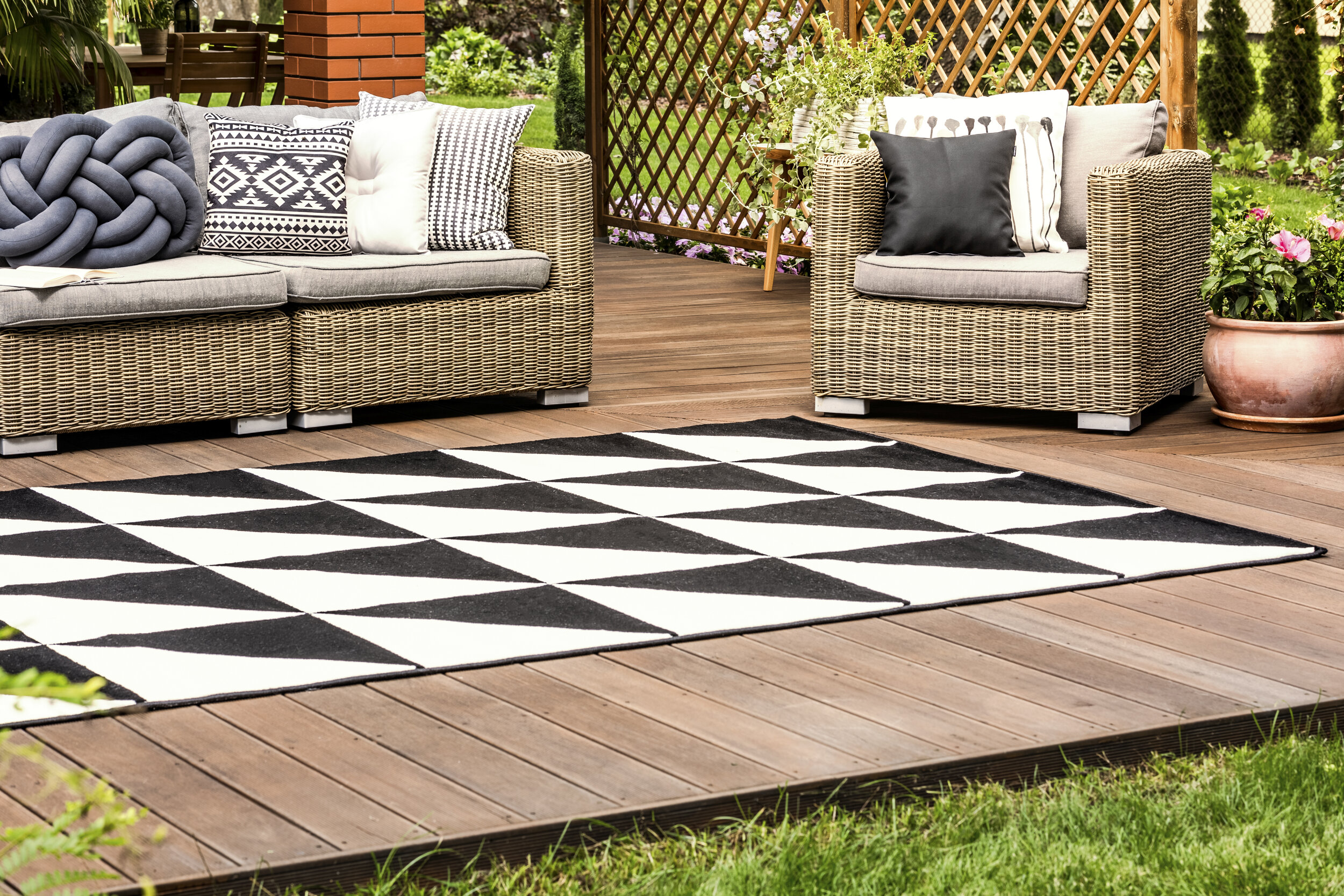What's the Difference Between Indoor and Outdoor Rugs?
Rugs make our living rooms, bedrooms, family rooms and basements cozier. Outdoors, too, rugs make our patios or porches feel warm and homey. As you search for the perfect rug for various spaces in your home and patio, you may be wondering whether it matters that you use an indoor rug or an outdoor rug, and which type of rug is the best choice for transitional areas such as sunrooms or covered porches. What’s the difference between indoor and outdoor rugs?
Rugs make our living rooms, bedrooms, family rooms and basements cozier. Outdoors, too, rugs make our patios or porches feel warm and homey. As you search for the perfect rug for various spaces in your home and patio, you may be wondering whether it matters that you use an indoor rug or an outdoor rug, and which type of rug is the best choice for transitional areas such as sunrooms or covered porches. What’s the difference between indoor and outdoor rugs? They’re similar, yet very different.
Knowing the difference between indoor and outdoor rugs can save you from accidentally ruining an indoor rug that wasn’t intended to be used in the great outdoors.
The main difference between indoor and outdoor rugs comes down to materials.
Indoor rugs are made to put comfort and beauty first. They are made to be soft and luxurious underfoot, and as a way to enhance the home’s design either as a backdrop for beautiful furniture, or as a bold design statement. Inside the home, it’s all about comfort and wool, silk, cotton, sisal, jute, sea grass, viscose, polypropylene, and nylon are the most common materials for indoor rugs. Quality indoor rugs are durable and long-lasting, but can’t stand up to the extremes of weather or constant moisture.
Outdoor rugs are made to put function first, favoring durability and weather-resistance over beauty, although today you can find a huge selection of gorgeous outdoor rugs that would do just fine in any indoor space. Think black and white geometric outdoor rug or bamboo outdoor rug. Outdoor rugs are made to withstand all weather conditions, so the best choices are often synthetics. Recycled plastic outdoor rugs are becoming popular. You can find outdoor rugs made from acrylic, nylon, polyester, polypropylene, or even recycled plastic. You can also find outdoor rugs made with sea grass, jute, and sisal. Although natural materials can hold up to moisture pretty well, the challenge with them is simply that they can be hard to clean since dirt is easily trapped in the weave and scrubbing natural grasses will quickly destroy them.
Can Outdoor Rugs Get Wet?
One of the biggest questions regarding the looks and longevity of outdoor rugs is: “can outdoor rugs get wet?” Being rated for the outdoors, it’s reasonable to assume that they can survive the occasional rain; but what if you live in a rainy area, or don’t want to bother putting your outdoor rug away for winter? The short story is that outdoor rugs are indeed designed to withstand “some” rain, but not prolonged wet periods.
Natural rugs will deteriorate quickly if they are not allowed to dry completely. Nylon, polyester, or polypropylene rug are as durable as it gets for wet conditions but even synthetic outdoor rugs will mildew if they are exposed to constant moisture. If you live where it rains a lot, consider a smooth outdoor rug that’s easier to dry off and won’t have pockets that can hold moisture. And be sure to take your outdoor rugs inside for the winter to prolong their lifespans.
Now we get to the burning question… Can indoor rugs be used outdoors?
No. With the exception of sisal, jute and seagrass (which can be considered indoor/outdoor materials to some extent, as they can be used in relatively protected areas such as covered porches, pavilions, gazebos or sunrooms), indoor rugs are not designed to hold up to UV light, dirt, and moisture. You might have seen pictures of nomadic desert peoples using gorgeous wool rugs to beautify their living spaces, but these rugs are not generally subjected to a lot of moisture; and they do not last forever: they fade in the sun, and eventually it becomes impossible to remove all of the sand and dirt that gets trapped within the weave. In general, you do not want to use indoor rugs outdoors.
Okay… Can outdoor rugs be used indoors?
Yes. Outdoor rugs can be used indoors and there are situations where they are better choices than indoor rugs. Outdoor rugs are much easier to clean since they are designed to resist dirt and water; and even if heavily soiled, they can be taken outside and hosed off, and left outside to dry (which they will, very quickly). By contrast, indoor rugs are not made to get dirty, and many can be notoriously difficult to clean. Once an indoor rug gets wet, it takes much longer to dry (putting it outdoors, upside down, can help).
Outdoor rugs are also made to be resistant to mold and mildew; and indoor rugs are not. If you enjoy having a rug underfoot beside the kitchen sink, for example, you might consider an outdoor rug that can stand up to the demands of a busy kitchen. Outdoor rugs can also be used in entryways where muddy shoes and paws would quickly damage an indoor rug, and in bathrooms instead of cheap and ugly bath mats.
What are indoor-outdoor rugs?
This hybrid type of rug has the look and feel of an indoor rug with the durability of an outdoor rub. Made of polypropylene synthetic fibers to resist moisture, stains and fading, these hard-wearing rugs outperform indoor rugs in terms of durability, which makes them perfect for entryways, kitchens, and other high-traffic areas.
Today, there are many choices in gorgeous outdoor or indoor/outdoor rugs that you can use wherever you want. Save the luxurious and more delicate indoor rugs for special places like a living room or bedroom, and hardier rugs elsewhere.

